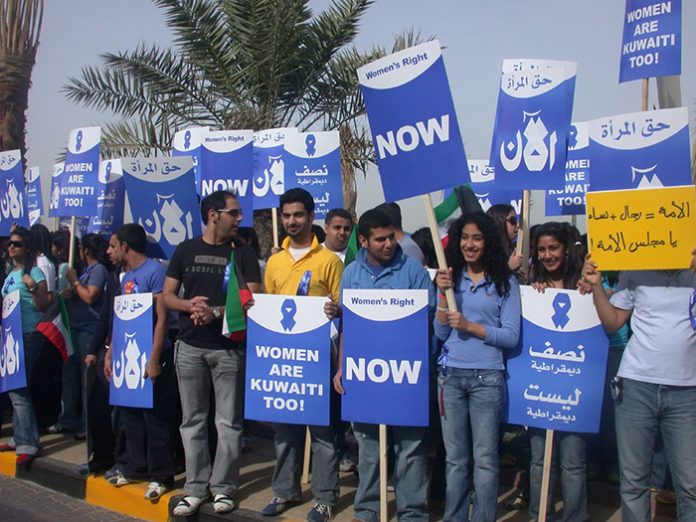THE TIMES KUWAIT REPORT
The need for Kuwait to enhance its human capital formation and to make it more gender equitable in order to spur the country’s economic growth and development was underlined in a recent report by the World Bank. The report urging greater gender parity, comes in the wake of the latest Human Development Report by the United Nations Development Programme (UNDP), which found Kuwait at 64th spot in the Human Development Index (HDI) for 2020, the lowest ranking among its peers in the six-nation Gulf Cooperation Council (GCC) bloc.
Kuwait has always prided itself on its high ranking in the region when it came to the Gender Development Index (GDI) developed by the World Bank. However, this is a rather simplistic scoring, gathered from the ratio of female HDI value to male HDI value, and captures only a small part of what human development entails. It does not for instance reflect on gender inequalities in reproductive health, empowerment and labor market employment, captured by the more composite Gender Inequality Index (GII). On the GII, the results for Kuwait were more mixed, achieving an overall ratio of 0.242, which was higher than that of Oman and Saudi Arabia, but lower than that achieved by Bahrain, Qatar and the UAE.
The country has also consistently scored high in gender parity when it comes to health and early education, but this equity, especially in education, has not translated into more women in the labor market. Available data shows that while boys and girls enrol in equal numbers at the primary level, as the educational level progresses there is a significant decrease in male students.
At the tertiary and university level women students far outnumber men, but despite this large pool of qualified women this has not translated into more women in employment. Figures show that while women make up 70 percent of university students in the country, they represent only a little over 30 percent of the workforce.
An explanation for this discrepancy could lie in the fact that men enter the labor pool at an earlier age, but with lower academic qualifications. On the other hand many women who are qualified often choose not to seek employment resulting in a huge human resource loss to the state.
The World Bank report attributed this inconsistency to a sharp mismatch between the qualifications of female graduates and the needs of the labor market. A large proportion of students seek to obtain degrees in the social sciences and humanities to work in the public sector, instead of obtaining degrees in science, technology, engineering, and mathematics, based on the requirements of the knowledge economy and the diversification agenda adopted by the government, said the bank.
The bank also noted that occupational discrimination has led to the concentration of women working mostly in the education and health sectors. Other surveys have shown that Human Resources (26%) and Healthcare/ Medical Services (24%) were the most attractive industries for female graduates in Kuwait. The bank report also highlighted that women occupy only a small percentage of leadership positions and senior management positions, with 15 percent in the public sector and less than 20 percent in the private sector. As of February 2021, only 1.5 percent of seats in parliament were held by women and the unemployment rate among women remains at 5.8 percent compared to 0.9 percent for men.
While the selective educational choices could be a valid reason for fewer women in the workforce, another more compelling rationale could be prevailing social mores and traditions that often discourage women from pursuing employment or empowerment outside their homes. As one social entrepreneur put it, “In Kuwait, some of the strongest opposition to women’s participation in employment and political fields have come from conservative women following traditions and social mores, which they believe their religion dictates.”
Though Kuwaiti women are generally considered more emancipated than their peers in other GCC states, this freedom of choice and expression is often confined to only a section of women. Ghada al-Ghanim, a social activist, laments that many women do not even realise that they have rights that have been granted in the laws or the constitution “Men and women are not aware of their rights,” says Ms al-Ghanim. “It is not enough to change the laws, it is very important to engage the society and explain that equal rights are not anti-Islamic.”
However, conservative views holding women captive is not a phenomenon limited to Kuwait. There are still many people around the world who believe it is unacceptable for a woman to have a paid job outside the home, but luckily their numbers are decreasing. In a recent global poll organized by the International Labor Organization (ILO) and conducted by the international firm Gallup Polls, revealed that only 20 percent of men and 14 percent of women globally believe women’s role is in the home.
The poll also found that in many developing and emerging countries, the lack of safe and accessible transportation is often a challenging factor for women who go to work. All too often, women risk facing harassment and even sexual assault on their daily commute. Ask any expatriate woman who has taken the public transport to work in Kuwait and they will invariably recount harrowing incidents of physical and verbal assault during their ride to work on Kuwait’s buses.
While a woman’s personal preference is a key factor in determining whether she will engage in paid work, this choice is often heavily influenced by socio-economic constraints that pressure her to conform to traditional gender roles. Traditions and social dictates may take time to change, but hopefully economic necessity could speeden this process. In many countries, the rapid pace of economic changes have led to a situation where women have little choice but to work to sustain their families. When asked if they preferred to work in paid jobs, care for their families, or do both, the ILO-Gallup poll found a staggering 70 percent of women, regardless of their employment status, preferring to work in paid jobs.
The data is clear: women want to be in paid employment, but a persistent set of socio-economic barriers discourage them from the workforce. By identifying and quantifying these barriers policymakers can develop smarter responses to eliminate or lower these hurdles. Ultimately, closing gender gaps in the labor force is not just good for women and their households, but for the global economy as a whole. Countries that fail to deliver on the hopes and dreams of women and men that Gallup and the ILO discovered through this project will fail to develop a booming economy and all the things that citizens want in a good life – which begins with a good job, said ILO.
Meanwhile, a more damning report on prevailing gender inequality in Kuwait and the region in general came from the annual Global Gender Gap Report (GGGR) prepared by the World Economic Forum (WEF). The report found Kuwait slotted in 143rd position among 156 countries indexed in 2021, ahead of Oman (145) and Saudi Arabia(147) but just behind Qatar (142), Bahrain (137) and far below the UAE, which ranked 72nd globally. Kuwait was ranked 122 in the report a year earlier, the sharp drop is in contrast to the rise in ranking registered by the UAE, which jumped 48 rungs up the ladder from the 120th spot it occupied in the 2020 report.
The GGGR measures the extent of gender-based gaps among four key dimensions — Economic Participation and Opportunity, Educational Attainment, Health and Survival, and Political Empowerment — and tracks progress towards closing these gaps over time.The overall gender gap index for Kuwait was 0.621 on a scale where 0 represented imparity and 1 represented full parity. On educational attainment and in health and survival Kuwait registered 0.997 and 0.968 respectively. However, dragging Kuwait down the ranking was its performance on economic participation and opportunity, where the country scored 0.498, and in political empowerment where it scored a dismal 0.022.
The GGGR for 2021 also underscored the fact that the Middle East and North Africa (MENA) region remains the area with the largest gender gap, having progressed only 61 percent towards attaining gender parity. The WEF expects that at the current relative pace of progress it would take another 142 years before gender parity is achieved in the region. Globally, across the four sub-indices measured by the GGGR, the largest gender disparity is on political empowerment, with only 22 percent of the gap closed to date. Across the world, women represent only 26 percent of some 35,500 parliament seats and just 23 percent of over 3,400 ministers worldwide. At the current rate of progress, the World Economic Forum estimates that it will take 146 years to attain gender parity in politics.
The second-largest gap is on Economic Participation and Opportunity, with only 58 percent of this gap having been closed so far. The WEF estimates that it will take another 268 years to close this gap. On average, only 55 percent of adult women are in the labor market, versus 78 percent of men, while over 40 percent of the wage gap (the ratio of the wage of a woman to that of a man in a similar position) and over 50 percent of the income gap (the ratio of the total wage and non-wage income of women to that of men) are still to be bridged. Further, in many countries, women are significantly disadvantaged in accessing credit, land or financial products, which prevents opportunities for them to start a company or make a living by managing assets.
The UNDP in its report on Kuwait also noted that many of the gender disparities could have become exacerbated by the ongoing COVID-19 crisis. In his recent remarks on the impact of the pandemic on gender equality, United Nations Secretary-General António Guterres noted that gender equality is not only a fundamental human right, but a necessary foundation for a peaceful, prosperous and sustainable world. He urged governments to place women and girls at the centre of their recovery efforts.
The UN Chief added, “Limited gains in gender equality and women’s rights made over the decades are in danger of being rolled back due to the COVID-19 pandemic. Putting women and girls at the centre of economies will fundamentally drive better and more sustainable development outcomes for all, support a more rapid recovery, and place the world back on a footing to achieve the Sustainable Development Goals.” The Sustainable Development Goals (SDGs) outlined by the UN General Assembly in 2015, are designed to be a blueprint to achieve a better and more sustainable future for all people and the planet. Goal 5 of the SDG is to “Achieve gender equality and empower all women and girls.”
Despite the passage of five years since the goals were outlined, many challenges remain to be resolved with regard to gender equality. No doubt, there has been some progress, more girls are now going to school, fewer girls are forced into early marriage, more women are serving in parliament and positions of leadership, and laws are being reformed to advance gender equality. However, discriminatory laws and social norms remain pervasive, women continue to be underrepresented at all levels of political leadership. Clearly, we have a long way to go before the world achieves its desired gender parity; in Kuwait the wait could be even longer.

















